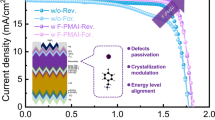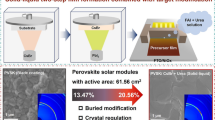Abstract
Poly(3,4-ethylenedioxythiophene):poly(styrenesulfonate) (PEDOT:PSS) stands as a prominent hole transport layer (HTL) in perovskite light-emitting diodes (LEDs), known for its remarkable electrical conductivity and light transmittance. However, its electron-blocking properties have shown limitations in achieving optimal charge balance by allowing excessive electron transport. To overcome this challenge, we introduce poly(triarylamine) (PTAA) as an intermediate HTL material between the PEDOT:PSS layer and the perovskite emission layer. By leveraging PTAA's higher lowest unoccupied molecular orbital (LUMO) level of 1.8 eV compared to PEDOT:PSS, a substantial energy barrier is established. This energy barrier effectively traps electrons within the emission layer, elevating radiative recombination rates and consequently enhancing overall efficiency. The notable LUMO energy gap of approximately 1.7 eV between PTAA and CsPbBr3 further contributes to efficient electron confinement. To optimize hole injection and promote charge balance, we address the highest occupied molecular orbital (HOMO) level mismatch between PEDOT:PSS and PTAA. This is achieved by incorporating perfluorinated ionomer (PFI) into PEDOT:PSS, inducing a band bending effect. The resulting energy level alignment leads to improved device performance. Experimental validation of this energy level engineering strategy in light-emitting diodes (LEDs) demonstrates substantial enhancements. The external quantum efficiency (EQE) achieves a remarkable 2.8-fold increase, advancing from 1.07% to 2.81%, when compared to devices employing PEDOT:PSS alone. Moreover, the current efficiency (CE) experiences a 2.5-fold augmentation, surging from 3.74 cd/A to 9.35 cd/A. The luminance levels soar by an impressive 11.3-fold, ascending from 1,745 cd/m2 to an impressive 19,780 cd/m2.




Similar content being viewed by others

References
K. Lin, J. Xing, L.N. Quan, F.P.G. Arquer, X. Gong, J. Lu, L. Xie, W. Zhao, D. Zhang, C. Yan, W. Li, X. Liu, Y. Lu, J. Kirman, E.H. Sargent, Q. Xiong, Z. Wei, Nature 562, 245–248 (2018). https://doi.org/10.1038/s41586-018-0575-3
W. Xu, Q. Hu, S. Bai, C. Bao, Y. Miao, Z. Yuan, T. Borzda, A.J. Barker, E. Tyukalova, Z. Hu, M. Kawecki, H. Wang, Z. Yan, X. Liu, X. Shi, K. Uvdal, M. Fahlman, W. Zhang, M. Duchamp, J.M. Liu, A. Petrozza, J. Wang, L.M. Liu, W. Huang, F. Gao, Nat. Photon. 13, 418–424 (2019). https://doi.org/10.1038/s41566-019-0390-x
Z.K. Tan, R.S. Moghaddam, M.L. Lai, P. Docampo, R. Higler, Nat. Nanotechnl. 9, 687–692 (2014). https://doi.org/10.1038/nnano.2014.149
H. Cho, S.H. Jeong, M.H. Park, Y.H. Kim, C. Wolf, Science 350, 1222–1225 (2015). https://doi.org/10.1126/science.aad1818
J.Q. Li, S.G.R. Bade, X. Shan, Z.B. Yu, Adv. Mater. 27, 5196–5202 (2015). https://doi.org/10.1002/adma.201502490
Z.G. Xiao, R.A. Kerner, L.F. Zhao, N.L. Tran, K.M. Lee, T.W. Koh, G.D. Scholes, B.P. Rand, Nat. Photon. 11, 108–115 (2017). https://doi.org/10.1038/nphoton.2016.269
N.N. Wang, L. Cheng, R. Ge, S.H. Zhang, Y.F. Miao, Nat. Photon. 10, 699–705 (2016). https://doi.org/10.1038/nphoton.2016.185
M.G. Yuan, L.N. Quan, R. Comin, G. Walters, R. Sabatini, Nat. Nanotechnl. 11, 872–877 (2016). https://doi.org/10.1038/nnano.2016.110
M. Ban, Y. Zou, J.P.H. Rivett, Y. Yang, T.H. Thomas, Nat. Commun. 9, 3892 (2018). https://doi.org/10.1038/s41467-018-06425-5
P. Chen, Y. Meng, M. Ahmadi, Q.M. Peng, C.H. Gao, L. Xu, M. Shao, Z.H. Xiong, B. Hu, Nano Energy 50, 615–622 (2018). https://doi.org/10.1016/j.nanoen.2018.06.008
P. Chen, Z.Y. Xiong, X.Y. Wu, M. Shao, X.J. Ma, Z.H. Xiong, C.H. Gao, J. Phys. Chem. Lett. 8, 1810–1818 (2017). https://doi.org/10.1021/acs.jpclett.7b00368
Y. Meng, M. Ahmadi, X. Wu, T. Xu, L. Xu, Z. Xiong, P. Chen, Org. Electron. 64, 47–53 (2019). https://doi.org/10.1016/j.orgel.2018.10.014
J.H. Kim, Y.K. Seo, J.W. Han, J.Y. Oh, Y.H. Kim, Appl. Chem. Eng. 26(3), 275–279 (2015). https://doi.org/10.14478/ace.2015.101
Y. Li, C. Liang, G. Wang, J. Li, S. Chen, S. Yang, G. Xing, H. Pan, Photon. Res. 8(10), A39–A49 (2020). https://doi.org/10.1364/PRJ.398529
Q. Wang, C. Bi, J. Huang, Nano Energy 15, 275–280 (2015). https://doi.org/10.1016/j.nanoen.2015.04.029
C. Bi, Q. Wang, Y. Shao, Y. Yuan, Z. Xiao, J. Huang, Nat. Commun. 6, 7747 (2015). https://doi.org/10.1038/ncomms8747
D.Y. Luo, W.Q. Yang, Z.P. Wang, A. Sadhanala, Q. Hu, R. Su, R. Shivanna, G.F. Trindade, J.F. Watts, Z.J. Xu, T.H. Liu, K. Chen, F.J. Ye, P. Wu, L.C. Zhao, J. Wu, Y.G. Tu, Y.F. Zhang, X.Y. Yang, W. Zhang, R.H. Friend, Q.H. Gong, H.J. Snaith, R. Zhu, Science 360, 1442–1446 (2018). https://doi.org/10.1126/science.aap9282
W.S. Yang, B.W. Park, E.H. Jung, N.J. Jeon, Y.C. Kim, U.L. Dong, S.S. Shin, J. Seo, E.K. Kim, J.H. Noh, Science 356, 1376–1379 (2017). https://doi.org/10.1126/science.aan2301
K.G. Lim, Polym. Sci. Technol. 28(6), 466–469 (2017)
K.G. Lim, S. Ahn, Y.H. Kim, Y. Qi, T.W. Lee, Energy Environ. Sci. 9, 932 (2016). https://doi.org/10.1039/C5EE03560K
H. Kim, K.H. Lim, T.W. Lee, Energy Environ. Sci. 9, 12 (2016). https://doi.org/10.1039/C5EE02194D
K.G. Lim, H.B. Kim, J. Jeong, H. Kim, J.Y. Kim, T.W. Lim, Adv. Mater. 26, 6461 (2014). https://doi.org/10.1002/adma.201401775
Y.H. Kim, H.C. Cho, J.H. Heo, T.S. Kim, N.S. Myoung, C.L. Lee, S.H. Im, T.W. Lee, Adv. Mater. 27(7), 1248–1254 (2014). https://doi.org/10.1002/adma.201403751
J. Song, J. Li, L. Xu, J. Li, F. Zhang, B. Han, Q. Shan, H. Zeng, Adv. Mater. 30(30), 1800764 (2018). https://doi.org/10.1002/adma.201800764
E.J. Bae, Y.H. Kang, K.S. Jang, S.Y. Cho, Sci. Rep. 6, 18805 (2016). https://doi.org/10.1038/srep18805
C.T. Howells, S. Saylan, H.R. Kim, K. Marbou, T. Aoyama, A. Nakao, M. Uchiyama, I.D.W. Samuel, D.W. Kim, M.S. Dahlem, P. Andre, J. Mater. Chem. A. 6, 16012–16028 (2018). https://doi.org/10.1002/adma.201403751
S. Ma, W. Qiao, T. Cheng, B. Zhang, J. Yao, A. Alsaedi, T. Hayat, Y. Ding, Z. Tan, S. Dai, ACS Appl. Mater. Interfaces 10, 3902–3911 (2018). https://doi.org/10.1021/acsami.7b19053
Acknowledgements
This research was supported by Korea Institute for Advancement of Technology (KIAT) funded by the Korea Government (MOTIE) (N0001415182419) and, National Research Foundation of Korea (NRF) funded by Ministry of Science and ICT (NRF-2020R1A6A1A03038697, and NRF-RS-2023-00246901).
Author information
Authors and Affiliations
Corresponding author
Additional information
Publisher's Note
Springer Nature remains neutral with regard to jurisdictional claims in published maps and institutional affiliations.
Rights and permissions
Springer Nature or its licensor (e.g. a society or other partner) holds exclusive rights to this article under a publishing agreement with the author(s) or other rightsholder(s); author self-archiving of the accepted manuscript version of this article is solely governed by the terms of such publishing agreement and applicable law.
About this article
Cite this article
Shin, G., Yun, D., Ha, Y. et al. Enhancing Performance of Perovskite Nanocrystal Light-Emitting Diodes with Perfluorinated Ionomer and PEDOT:PSS. Trans. Electr. Electron. Mater. 25, 40–47 (2024). https://doi.org/10.1007/s42341-023-00499-9
Received:
Revised:
Accepted:
Published:
Issue Date:
DOI: https://doi.org/10.1007/s42341-023-00499-9



